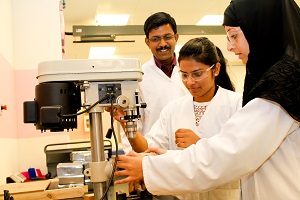
Students Mariam Al-Jaberi and Bidisha Ghosh operate a drill press during a workshop on the women’s campus at the Petroleum Institute.
(Courtesy of the WiSE Program, Petroleum Institute)
In the year 2000, the United Arab Emirates was on a roll. In the three decades since its founding, the coastal nation bordering the Persian Gulf had evolved from an impoverished desert populated by nomadic tribes to a glistening economic hub with one of the world’s highest per-capita GDPs. Its largest state, Abu Dhabi, was home to one-tenth of the world’s known oil reserves, and the economy was growing at a dizzying pace as the state-owned
Abu Dhabi National Oil Company (ADNOC) moved to ramp up production. But the region lacked one critical asset: a top-notch science and engineering school.
“They were spending all this money on scholarship programs to send students to Western countries for an education,” recalls Nigel Middleton, Mines’ senior vice president for strategic enterprises. “They wanted to create a world-class technical university to enhance the fabric of their own country.”
After an exhaustive review of proposals from 20 universities, ADNOC tapped Mines to be its model, partner, and guide for the ambitious venture. ADNOC would foot the bill, along with Shell, Total, BP, and the Japan Oil Development Company. Mines would provide the blueprint and help with administration. A year later, in 2001, the Petroleum Institute (PI) in Abu Dhabi welcomed its first all-male crop of students. Today, the PI boasts more than 2,000 students (including a growing contingent of women), a reputation as one of the finest academic institutions in the Middle East, and a continuing cross-cultural collaboration with Mines.
“We watched this go from a dream to now a fully operating university offering high quality education,” says Middleton, who with emeritus professor Robert Baldwin, was instrumental in planning and developing the PI. “It has been quite exhilarating.”
A CHALLENGING START
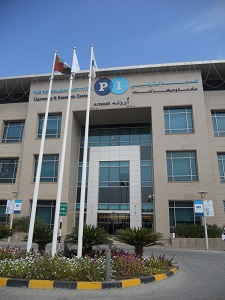
This image shows the facade of Arzanah, the headquarters of the women’s college at the Petroleum Institute.
(Credit: Debra Lasich)
From their offices in Golden, Middleton and Baldwin hunkered down for 12 months in 2000 to swiftly develop a curriculum, administrative procedures, and architectural suggestions for building a top-flight scientific university from a vacant patch of dirt 8,000 miles away. Every six weeks, they’d board a plane for the 20-hour flight to Abu Dhabi to present their ideas to the ADNOC leaders (many of them revered Arab sheiks). They took care to comply with local decorum—wearing long pants, ties, and jackets, even on the hottest of days—and respect local religious customs.
Mines had a lot at stake. “It was an opportunity for us to have a footprint in the UAE, one of the major oil-producing countries in the world. It was a high-profile partnership that gave Mines a more global presence,” recalls Middleton.
On September 10, 2001, Middleton stood proudly at the entrance to the modest 12-classroom building that comprised Phase One of the new PI campus and welcomed its inaugural class of 139 men. The next day, as he packed to go home, he flipped on the television and watched the second plane crash into the World Trade Center towers.
“We were totally shattered,” recalls Middleton, who didn’t get home to Colorado for two weeks, due to flight cancellations. Once he did, he was very worried. “The UAE is a very peaceful country, but we had no idea what the spillover might be in the Middle East,” and what it might mean for the newly opened institute. Fortunately, within about a month, life in Abu Dhabi was largely back to normal, and the Institute’s first year was in full swing.
Inside the PI’s walls, Mines faculty—who had moved there to help get the institution off the ground—faced their own challenges as they dealt with different learning styles and expectations from students.
In an Arab culture deeply rooted in oral tradition and respect for elders, education often relied heavily on rote memorization and recitation. As a result, many incoming students lacked strong reading and critical thinking skills and had trouble thinking outside the box, recalls Mines emeritus professor John Golden, who served as the PI’s first academic vice president. Many had never conducted a hands-on experiment in a laboratory before.
To bridge the gaps, the PI developed a Foundation Year program, in which incoming students learned to master English and computer skills and recognize the importance of curiosity-driven science and independent learning.
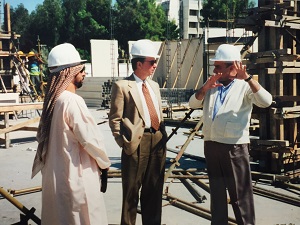
Dr. Robert Baldwin, Emeritus Professor and former Head of Chemical Engineering at Mines, consults with ADNOC civil projects engineers on the construction of the founding building of the Petroleum Institute (circa 2001).
(Courtesy of Nigel Middleton)
The most notable cultural difference, however, was the absence of women. “About a year after I got there, I started advocating for them to bring women to campus, but they were just not ready,” says Golden. But it wasn’t long before that changed.
In 2006, the last year Golden and his wife Lynn (a counselor at the school) were there, the PI enrolled 104 women to study at a separate female-only campus. When those women graduated a few years later, the Goldens returned so John could deliver the commencement speech. “It was just wonderful to go back and see that happen,” says Lynn. “I really marvel at the amount of progress that has been made there in such a short time.”
ONGOING EXCHANGE
Today, the relationship between the two institutions remains solid. About a dozen graduating PhD students from Mines have moved to Abu Dhabi to teach at the PI, alongside an international faculty of 200 (the PI is now accredited by the U.S.-based Accreditation Board for Engineering and Technology). Numerous PI graduates have come to Mines to earn their advanced degrees. And thanks to a growing PI emphasis on research, co-investigators from each campus now collaborate on research projects, exploring topics such as developing a better fuel cell for cleaner energy production, building robots to monitor scorching hot refineries, and enhancing oil and gas recovery from the geologically unique reservoirs of the Middle East.
While the men’s and women’s undergraduate campuses remain segregated (a situation Middleton and others hope to ultimately see changed), women now account for more than half the student population at the PI. “The women’s program there has been just phenomenal,” says Middleton.
During summer 2015, 18 female undergraduate students flew to Golden for a two-week visit packed with cultural and educational programming. They stayed in the dorms on campus, attended a lecture at a local Islamic center, went ziplining in Vail, and hiked to the top of South Table Mountain. “The sense of achievement and joy of making it to the top was overwhelming,” says Maryam Mardood, a second-year PI student majoring in petroleum geosciences.
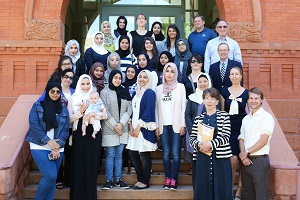
Petroleum Institute students pose with Mines faculty and staff outside Engineering Hall.
(Credit: Deirdre Keating)
The women also participated in an intensive workshop led by instructors from Mines’ EPICs Design and Humanitarian Engineering Program. Their assignment: to seek out stakeholders affected by a mock proposed drilling operation atop South Table Mountain and address their concerns in the design plan. “This whole concept of consulting stakeholders and working their needs into your design is becoming not just fashionable, but necessary, in the industry today,” says humanitarian engineering instructor Ben Teschner, who has since developed a whole course modeled after that two-week workshop.
The women fanned out across Golden, interviewing a pre-screened bike shop owner, a realtor, a neighbor, an open space worker, and a professor. Then, they presented their plans to the mock client, Ray Priestley, a real-life business development advisor for Encana Corporation.
Some workshop attendees developed elaborate plans to use helicopters to mitigate traffic concerns. Others mapped out underground tunnels to reduce the project’s impact on the skyline. Many say they walked away with new skills and a heightened sense of confidence. “The design workshop taught me that by believing in my capabilities, believing in my ideas, and working hard, I can create innovative solutions to the different challenges I might face,” says Mardood.
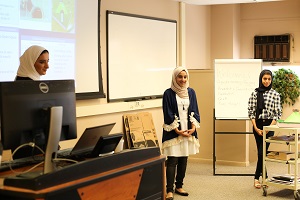
Petroleum Institute students present design prototypes to their client, Encana Corporation, during the summer course held on the Mines campus in July 2015.
(Credit: Deirdre Keating)
Priestley says he gained a lot from the experience, too. Prior to meeting the women, he admits that he had a preconceived notion that they would be quiet and reserved. They were nothing like that. “It was a real eye-opener for me,” he says, referring to the encounter as an example of how people from other parts of the world are “more like us than different from us.”
“I only hope we made as good an impression on them as they made on us.”


